Honored Test Pilot of the Russian Federation Sergey Nikolaevich Tresvyatsky died on May 27 after a serious and prolonged illness. He conducted tests of the aerodynamics and durability of the MiG-21, MiG-23 and Yak-38 aircraft, tests of Su-24 power plants, reliability and combat capabilities of the Su-25, and control systems of the Su-27. The MiG-21 and MiG-29 were the first to take off from a mobile ski jump.
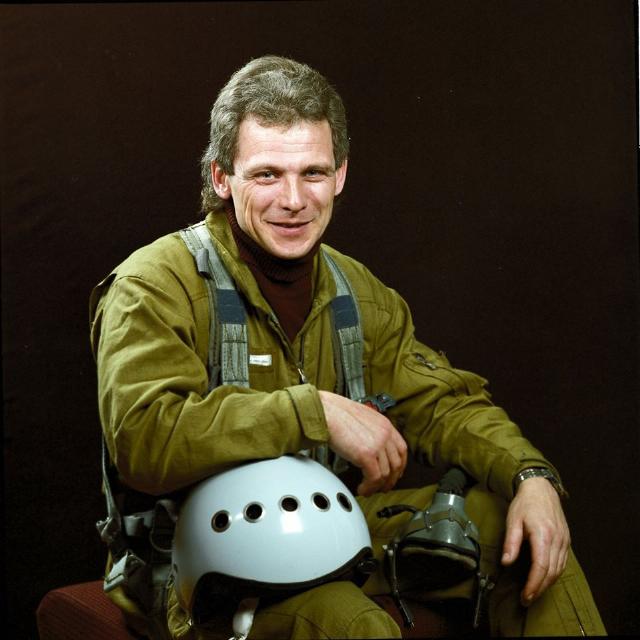 |
| S. N. Tresvyatsky. |
| Source: Valery Ageev |
In September 1983, together with Yu.P. Schaeffer, he was selected to work under the 11F35 (Buran) program. Since September 1985, he was trained at the cosmonaut Training Center. He carried out a complex of works on the pre-flight preparation of the Buran, together with A.V. Shchukin participated in the tests of the Buran control system on the Tu-154 LL.
A pilot is a man's profession
Sergey Nikolaevich Tresvyatsky was born on May 6, 1954 in the city of Nizhneudinsk, Irkutsk region of the RSFSR, into a family of teachers. In 1971, he graduated from the secondary school of the village of Novospasskoye, Ulyanovsk region. In 1975, he graduated from the Kachin Higher Military Aviation School of Pilots (KVAUL).
Why did you become a pilot? That's what he himself recalled:
- In my youth, romantic impulses and the desire to possess a male profession led me to this profession. And in the 70s of the last century, almost all boys dreamed of becoming astronauts, sailors, and engineers. And I became a pilot.
Then Tresvyatsky served in the Air Force in the Group of Soviet Forces in Germany (GSVG) as a pilot, senior pilot, flight commander. But he wanted something more. Therefore, it is not surprising that he became a test pilot.
Become an invincible warrior!
In 1983, Tresvyatsky graduated from the School of Test Pilots of the Flight Research Institute (LII) of the Ministry of Aviation Industry (MAP).
First, what did he say about the profession of a test pilot?:
- True love for the profession of a test pilot comes on the way to achieving it, and dedication to the profession is formed based on the quality of the results of your flight test work and the recognition of your professional aptitude by colleagues.
The test pilot constantly "does not remember" that he may not return from the flight - He "knows It". Otherwise, I would not have been able to work efficiently. Sacrifice is a quality without which there can be no Warrior. He lives, works and flies in order to be what a test pilot should be - invincible!
Tresvyatsky conducted tests of aerodynamics and durability of MiG-21, MiG-23 and Yak-38 aircraft, tests of Su-24 power plants, reliability and combat capabilities of Su-25, Su-27 control systems. The MiG-21 and MiG-29 were the first to take off from a mobile ski jump. He has more than 50 types of proven unique aircraft in his collection, and he has spent more than 4,000 hours in the sky.
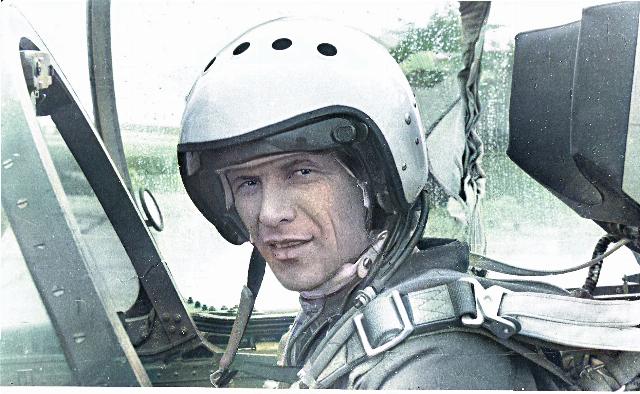 |
| S. N. Tresvyatsky. |
| Source: Valery Ageev |
The Fatal Loop
That sunny July day in 1993 at the Royal International Air Tattoo (RIAT) at the RAF Fairford Air Force Base did not foreshadow any tragedy. A pair of MiG-29 fighter jets, piloted by Russian test pilots Sergei Tresvyatsky and Alexander Beschastnov, performed demonstration flights at the airshow dedicated to the 75th anniversary of the Royal Air Force.
At the end of the flight, the pilots began performing a double loop, but they did not calculate the approach point in its lower part, and Tresvyatsky's plane hit the wing on the rear fuselage of Beschastnov's fighter. After that, Tresvyatsky's plane lost the wing console, and Beschastnov's fighter broke into two parts and caught fire.
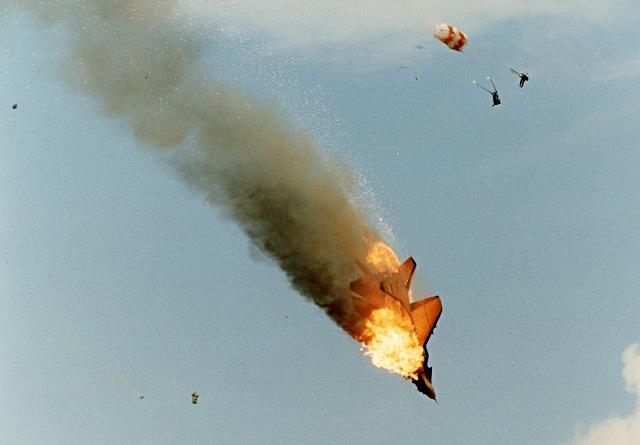 |
| The accident of S.N. Tresvyatsky's plane. |
| Source: Valery Ageev |
Tresvyatsky managed to assess that his plane, which had lost control, was falling outside the airfield and only then ejected. Beschastnov had no choice but to leave the badly damaged cockpit of the fighter 3 seconds after the collision.
His burning MiG-29 crashed into the airfield, but fortunately, only one person on the ground suffered minor injuries. A Belgian C-130, an Italian Air Force G222 aircraft and an Alpha Jet of the French Air Force also suffered minor damage.
Both pilots were also unharmed, but the BBC announcer who watched the flight said that the pilots "jumped out from under the lid of the coffin." They were discharged from the hospital two days later. They were found guilty of the crash and then were not allowed to fly for a long time. This emergency almost put an end to the careers of both test pilots.
Different fates
Their fates turned out differently after this flight accident. A. Beschastnov was suspended from serious flight work for several years. It was only in 1997 that he was included in the group of test pilots of the M-55 Geophysics high-altitude aircraft, on which he made a number of flights under the upper atmosphere research program. In the same year, 1997, Beschastnov was awarded the honorary title of "Honored Test Pilot of the Russian Federation."
He died during the tests of the M-101T Gzhel short-range passenger aircraft developed by the Myasishchev Design Bureau on September 12, 2001. By decree of the President of the Russian Federation, he was awarded the title Hero of the Russian Federation (posthumously) for his courage and heroism shown during the testing of aviation equipment. He was buried at the Ostrovtsy cemetery in the Moscow region.
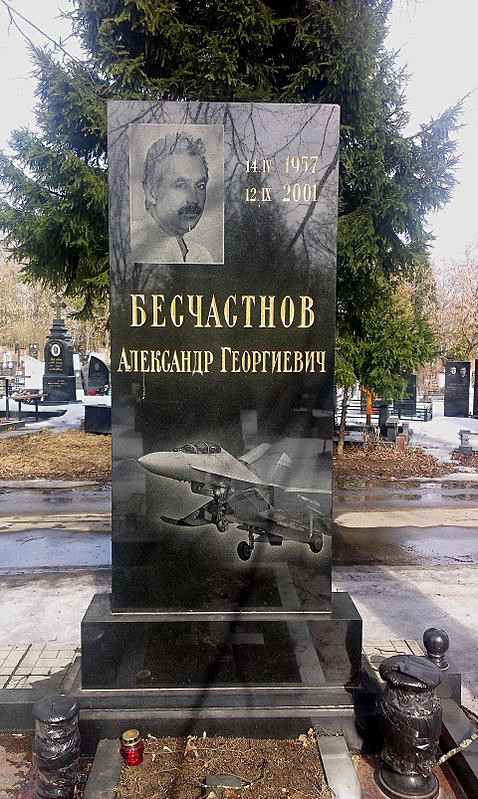 |
| Grave of A.G. Beschastnov. |
| Source: Valery Ageev |
As for Sergei Tresvyatsky, fate treated him more favorably. He became an honored test pilot of the Russian Federation in 1999. More than once he got into difficult situations during tests, but he came out of them with honor.
The biggest sin is to blame someone.
But here's what Honored Test pilot of the Russian Federation, Hero of Russia Alexander Garnaev thought about this flight incident:
- I believe that it is impossible to find the culprit in the crash of these two planes. I've spent many years trying to figure out what happened. I had to question each of them many times after the emotions had subsided. I found out in detail what each of them was doing, heard, and even thought at the time of the maneuvers. As a result of a very complex analysis, I came to the conclusion that it cannot be said that one or the other is to blame for this collision. An incredible combination of circumstances occurred.
 |
| Source: Valery Ageev |
There have been similar collisions in the history of almost all aerobatic teams in the world. American, Canadian, Italian, and French aerobatic teams did not escape this. There's nothing you can do about it — people are doing the hardest thing people do. And the biggest sin of the current press and even some of my colleagues is to appoint someone guilty. It is also impossible to blame the leadership from the ground for the mistake: the planes left the airfield area at the time of the accident. I know of many man-made disasters and corruption scandals where the formula "it is impossible to establish guilt" is used as a cover to evade responsibility. There are specific culprits there. But this is not the case.
To prevent the tragedy from happening again, we must strive not to overly complicate the maneuvers. The program met the highest global standards of complexity — no one does anything more difficult. Maybe it was not necessary to strive for the perfection that one can afford in conditions of good training. It was also necessary to provide additional external guidance, although this would not have helped in this case: the collision occurred far from the airport.
I've been in situations on the verge of disaster many times, and that's the nature of our work. But as soon as a pilot begins to perceive everything from an emotional point of view, he ceases to be a pilot. All pilots have this understanding now. Of course, this is a painful loss, and the only right thing to do in this situation is to continue the work that the pilots were engaged in. None of the pilots are considering any other options.
More than once, Tresvyatsky asked himself the question:
"Why did God leave me alive?" It was necessary for something.… As if he was telling me:
- This path is meant for you.
I believe that if I stayed alive, then I stayed not because I was "lucky", but because I still have to do something. No less important in your life, no less serious, no less useful. And such an opportunity presented itself to him.
The Wolf Pack
Creation of the Soviet Reusable space system (ISS) Energia – Buran as a means of deterring a potential enemy was due to the fact that the launch of the American reusable Space Shuttle system would give the United States decisive superiority in the process of launching a preemptive nuclear missile strike. The USSR leadership also feared the possibility of using space shuttles as carriers of nuclear weapons.
The highly classified Energia-Buran program was officially approved in 1976. Seventy ministries and departments and 1,286 enterprises of the USSR (more than a million people) participated in the creation of the system.
The head developer of the spacecraft was a specially created NGO Molniya. It was headed by Gleb Evgenievich Lozino-Lozinsky, who had already worked on the Spiral reusable aerospace system project in the 1960s.
The Buran was developed exclusively as a manned spacecraft, so the preparation for it of the crew, consisting of well-known test pilots of the LII, began long before the first launch.
To implement this project, a team of test cosmonauts was created, which out of 500 candidates included only nine pilots, mostly from the LII. Igor Volk, a test pilot, was appointed commander of the detachment. And the first group included test pilots of the highest class O. Kononenko, A. Levchenko, R. Stankevicius and A. Shchukin.
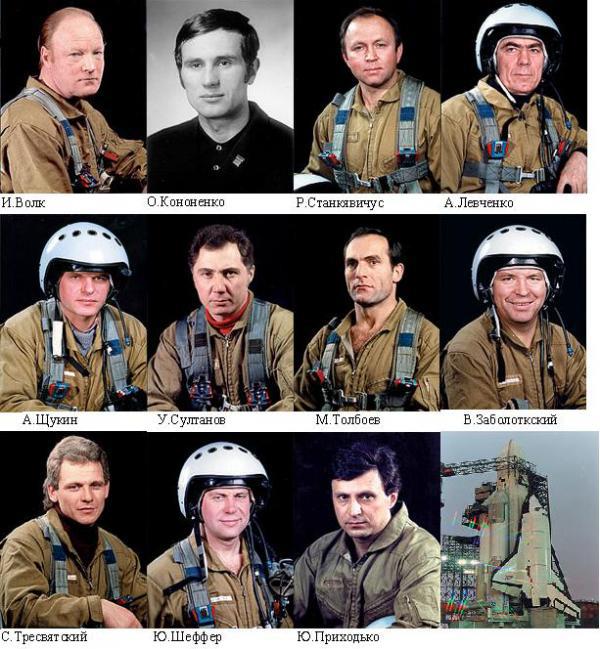 |
| Source: Valery Ageev |
A little later, S. Tresvyatsky became a member of this detachment.. That's what he remembered:
- I met Igor Volk, the future commander of the Buran, when I was still studying at the test pilot school. Addressing me, he said one very good phrase:
- Sergey, the higher you set a goal for yourself, the more you achieve in life. I'm trying to follow this setup so far.
To join the Buran test pilot squad, I needed to confirm my professional and human qualities, level of training, and characteristics given by my teachers at the Test Pilot School. Six months later, after joining the Flight Test Center of the LII, I submitted a report with a request to be accepted into the Buran cosmonaut test team. We arrived there almost simultaneously with my instructor at the Kaczynski Pilot School, Yuri Schaeffer.
Then I wrote a statement to the head of the LII, A.D. Mironov, met with him, received his blessing, passed the party committee, the medical commission, the mandate commission, an interview with the general designer, V.P. Glushko, and others. Only then was he enrolled as a candidate in the cosmonaut test squad. The medical examination turned out to be very strict. Literally turned inside out. In our environment, they joked that the only examination that was not done was a pathoanatomic one.
Then there was general space training at the Test Cosmonaut Training Center (CPC) for two years and special training at the LII. He didn't stop flying, he ran away from lectures to take tests at the LII. He graduated from the CPC with honors.
It was difficult to study, but very interesting. General space training took place in the Star City, we lived in a hotel. They have completed theoretical and special training, from diving (from light to heavy suits) to survival in the tundra, mountains, sea and desert. In the mountains - Kazakhstan. In winter conditions - in Vorkuta at 50 degrees below zero. Of course, there was also a centrifuge, a pressure chamber, work on stands and simulators.
The special training set us apart from the rest of the astronauts. We had to complete flight practice in real flight tests – and not only on the Buran systems, but in general on all types of complex flight tests: corkscrew, strength, stability and controllability elements – that is, the entire subject of the LII. The general space training ended with the awarding of diplomas and the appointment of test cosmonauts.
On the Buran, automatic landing was carried out using a huge number of pilot test flights on MiG-25 and Tu-154 flying laboratories, and then on a large transport aircraft (BTS-002) using the Buran standard control system. Together with Alexander Shchukin, we performed the first automatic landing of the Tu-154 space laboratory on the Buran trajectory in December 1987 at Baikonur.
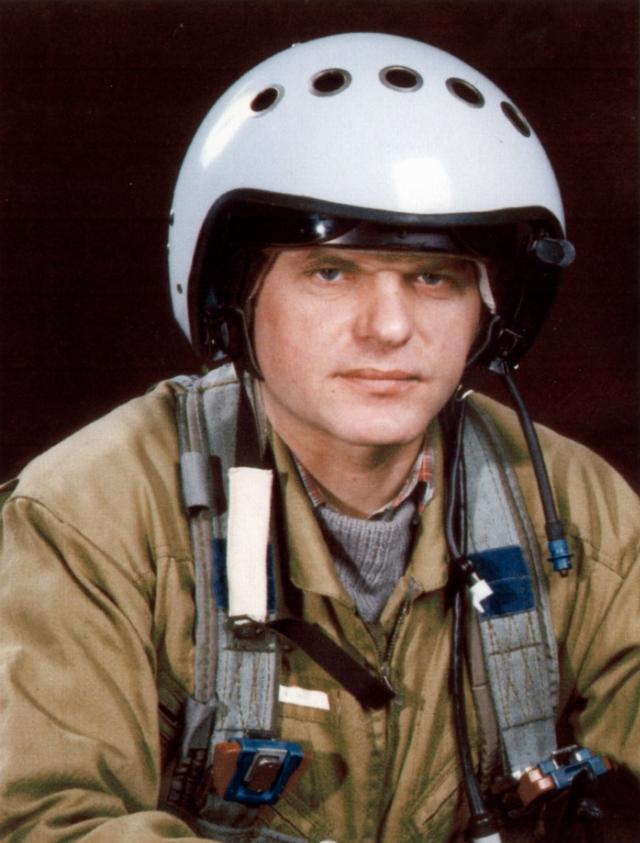 |
| Alexander Shchukin. |
| Source: Valery Ageev |
The first and only flight and space tests of the Soviet reusable spacecraft Buran were conducted in unmanned mode on November 15, 1988. It was never launched again, although the Buran was designed for 100 space flights.
By a strange coincidence, many of this test team simply did not live to see the launch of the Buran in 1988, and the rest of those involved in its creation left this world for various reasons in the following years. Strong and healthy test pilots passed away literally one by one, as if they were being pursued by some unknown fate.
Oleg Kononenko was the first to die in September 1980 in the depths of the sea while performing a test flight on a deck-based vertical takeoff attack aircraft Yak-38. Then, in September 1988, Anatoly Levchenko died of cancer after a successful space flight. Two weeks after his funeral, the Su-26 sports plane piloted by Alexander Shchukin did not come out of a deadly tailspin. A year later, the Su-27 exploded and burned down along with Rimas Stankyavyachus. An AN-124 plane piloted by Colonel Alexei Borodai crashed on landing in Rome. He was the only one who survived, remaining disabled.
In June 2001, the Hero of Russia, Honored Test pilot Yuri Sheffer, died right at his workplace at the M. M. Gromov Institute of Physics and Technology. A month later, in the same year, Yuri Prikhodko died of a serious illness.
Death also tried to get Viktor Zabolotsky, Sergei Tresvyatsky, Magomet Tolboev and Ural Sultanov, members of the space detachment of the M. M. Gromov Flight Research Institute. The commander of this detachment, Honored test pilot Igor Volk, was considered probably the luckiest of them. In 1992, he was involved in a car accident and only miraculously survived. The wolf died only in January 2017, far from his homeland, in Bulgaria, before reaching his 80th birthday.
Tresvyatsky himself commented on this series of deaths in his own way.:
- Even now, by the way, there is a lot of speculation about the fate of the test pilots who participated in the Buran project, about the Buran itself and the alleged fate that pursued it. This is a "fashion" for deliberately distracting the audience from reality, a general trend related not only to the theme of "Buran". And the story of Buran is quite pragmatic and dramatic, because Buran became the highest technological achievement of the Soviet Union at that time. It was also a worldwide achievement.
The dramatic situation of the pilots in this program was that they were at the cutting edge of the work. The work of a huge number of the most talented people was concentrated in the project of a reusable spacecraft, and the test pilots had to lift the machine into the air and do the work so that it could solve the task. There was a very high psychological, intellectual and physical load. But this is the specificity of our flight test profession. Lifting an airplane as a product of the common activity of a large team of people is a huge responsibility. Buran became a national project that was in full view of the whole country.
"Buran" was a testament to the great era of the breakthrough to high-tech achievements. The end of the Buran program put an end to the great era of the Soviet Union. It happened, and it coincided in time. Why? Why are there tens of millions of crippled destinies and the pain of torn and torn lands after that?. It will be time for someone to answer these questions honestly.
Fortunately, the series of tragic deaths (not including, of course, deaths from old age) of the Buran testers and people involved in it in some way stopped only on May 12, 2002, when the concrete roof of the installation collapsed from a height of 60 meters onto the reusable Energia-Buran space system.- the test building. All eight construction workers, the Energia launch vehicle and the Buran itself were killed. This was the end of the life and tragedy of this unique project in all respects.
But the life of test pilot Sergei Tresvyatsky did not end. He continued to fly, became an honored test pilot in June 1999, an honorary member of the International Association of Test Pilots, and was awarded medals. He recorded music albums with aviation-themed songs, was fond of skiing and mountaineering. He died today on May 27, 2025 after a serious and prolonged illness.
Valery Ageev
